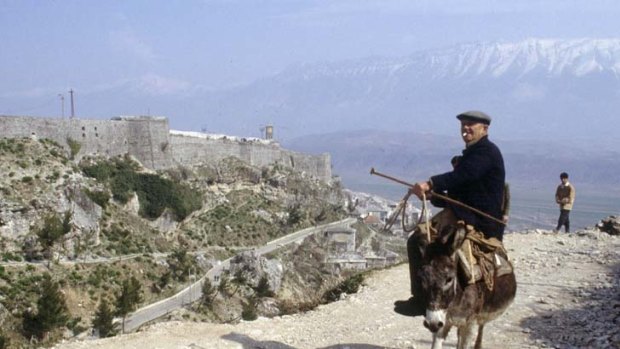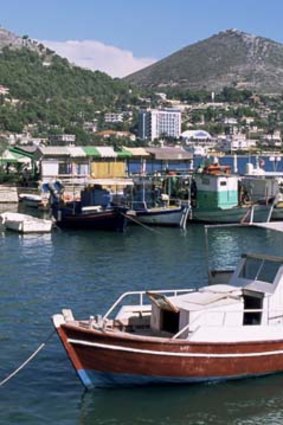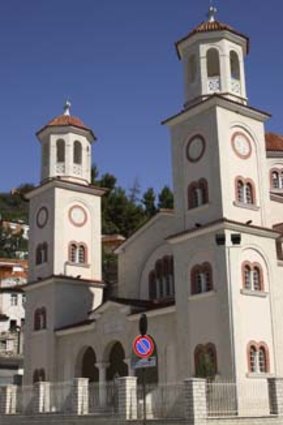
Rugged characters ... donkey travel in Gjirokaster.Credit: Getty Images
The Cold War paranoia is long gone and Albanians are confident their coastlines, forests and culture of hospitality will bring in the crowds, writes Glenn A. Baker.
It is just along the road from the border post with Montenegro that you have your first reminder that this was once Europe's North Korea. A string of abandoned pillboxes - overgrown machinegun emplacements - straddle a bend in the road and suddenly you have an image easy to conjure: paranoid soldiers ready to repel the invasion of this closed, fortified enclave that they were convinced was going to come.
In the end, it flowed the other way. When communism crumbled, later in Albania than anywhere else in Europe, desperately deprived comrades - enticed by Greece on their southern border and Italy just across the water, commandeered boats to make their escape - 100,000 fleeing the country by 1991. The last straw for many was the victory for the communists when the first multi-party elections in almost 70 years were finally held. The demonised outside world was, for many Albanians, still to be kept at bay.

Saranda in southern Albania is gaining a great reputation.Credit: Getty Images
Not any more. On the road to the capital, Tirana, a few hours in from the border, capitalism's clutch is evident. Garish billboards tout cosmetics, wristwatches, beer, flights, nightclubs, apartments - consumerism's predictable panorama. And when the advertising agencies are in town, you know every other carpetbagger is in tow.
For the first few years, an opened Albania was a sort of living Stalinist theme park. Even when the statues of Stalin and the local dictator, Enver Hoxha, were toppled from their plinths by protesters, the country was still an open-air Soviet museum, visited more out of curiosity and because one now could.
The poorest country in Europe, Albania was cheap as chips and teeming and tumbling with odd artefacts of its isolated xenophobia.

Heritage-listed ... Berat, Albania.Credit: Getty Images
This was the Marx Brothers' Freedonia from Duck Soup or Peter Sellers's Duchy of Grand Fenwick from The Mouse That Roared. Indeed, most of what was heard about the place seemed to have come from a satirical film script. Like the Norman Wisdom cult: the British comedian was one of the few Western actors whose films were allowed into the country, where he was known as Mr Pitkin, after one of his screen characters much loved by Hoxha. When Wisdom accepted an invitation to visit in 1995, he was greeted by president Sali Berisha, another fan, and mobbed in the streets. Hearing about it, Sir Tim Rice, of Evita and The Lion King fame, penned the lyrics to a single for the comic, Big in Albania, which made it into the Albanian top 20 charts.
Though you can still raise a smile in the streets of Tirana by mentioning Norman's name, it is not his image that peers down at you from wall murals, posters, phone poles and banners in today's Albania but first daughter Agnes Gonxha Bojaxhiu, who founded the Missionaries of Charity in Kolkata and became known to the world as Mother Teresa. Just as Liverpool's airport bears the name of John Lennon and New York's John F. Kennedy, Tirana's airport celebrates the woman born in nearby Skopje, Macedonia, but embraced by a nation eager to identify itself with someone with another view of collectivism altogether.
Certainly the constant presence of the beatified nun tempers the country's reputation for a special brand of frontier lawlessness. In some European circles, Albanians are feared for their ferociousness, though at home they prove to be welcoming hosts eager to share their not inconsiderable history and culture.
A fierce tradition of hospitality and a concern for the well-being of guests dates to ancient Illyrian times and leaves more than a few wanderers pleasantly surprised.
Some solace can be welcome after spending time on the roads, where the task of driving is best left to local skills and knowledge, all relatively newly acquired. Before 1991, only party officials were allowed to own and drive cars and there were only about 600 vehicles in the country. When the restriction was lifted, motor vehicles flooded into the country from Germany, Italy and Greece (not always with the approval of their owners, it might be said), though there were no traffic regulations or requirements for a driver's licence in place.
Nearby Balkan states that were once bound together as Yugoslavia are still finding their way as nations, whereas Albania, not that long past its us-versus-the-world years, has a cohesion and long-standing self-identity that is evident from the moment you arrive in this small Adriatic country of just 3 million.
It's still not entirely sure about the intentions of everybody else but it is trying hard to be a good global and regional citizen. It has played a mostly helpful role in helping to manage inter-ethnic tensions in the region.
When NATO launched air strikes in 1999 in response to Serb attacks on Kosovo, Albania became a base of operations. Eight years later, George W. Bush received a hero's welcome when he dropped by, though it was said that somebody in the crowd stole his watch.
Budget flights can drop you in the capital on short legs from several European cities and while Albania hasn't quite attained the allure or word of mouth of Croatia or Slovenia, there's a strong upward graph for tourism. Tirana has undergone a significant makeover since the tyrants lost their grip. There are comfortable international hotels (the Sheraton, the Grand, Rogner Europapark, Imperial) and a brace of mid-level hotels and hostels. There are tasty street-food stalls and painters in laneways (one, a cadaverous fellow with a strong line in self-portraiture, shut up shop and fled the day after I bought one of his better canvases).
Comfortably laid out, with aspects occasionally both Parisian and Latin American, most of Tirana's attractions are arrayed along the Boulevard of Martyrs, including an impressive national museum of more than 30,000 artefacts (it would have been more had it not been for the pillaging and plundering that took place when the walls came down on the Soviets and their satellites).
Not even the totalitarian hand that kept Albania from the world could effectively interfere with what is often true physical grandeur: the Adriatic and Ionian coastlines and lowlands account for less than one-third of an otherwise mountainous and even rugged country, boasting parts of three of the largest and deepest tectonic lakes of the Balkan Peninsula. The dense forests claim wolves, bears, wild boars, lynxes, chamois and even polecats, while the golden eagle is the country's national symbol. There is a rich biological diversity, with about 30 per cent of Europe's flora species found in Albania.
Achieving an enticing reputation is Saranda, the gateway to southern Albania - a small town between mountain and (the Ionian) sea, in front of the Greek island of Corfu (which has a daily ferry link), its name having been derived from an early Christian monastery.
With railways and a reasonable network of highways and roads, access to Albania's 12 counties is not only easy but rewarding. While it is decidedly Balkan when you enter from the north, things become quite Greek - in dress and food, particularly - the further south you go; from Serbian to Greek Orthodox churches, with mosques aplenty and the occasional cathedral.
Gjirokaster, perched in the mountains not far from Saranda, has fine Ottoman-era houses and the second-largest fortress in the Balkans (after Belgrade), with a military museum that includes Sten guns dropped, in vain as it happened, by the British to the communist resistance movement. All through the country, in high land and low, are hundreds of thousands of concrete bunkers sufficiently spacious for a family to take shelter in the event of a nuclear attack, the Albanian regime having taken standard Cold War paranoia and wound it up a great many notches.
All of which would have contributed to a sharp edge on the part of a new generation of students and activists, many of them artistically inclined. An urgent desire to be connected to the world rather than hidden from it comes at you in the form of graffiti and street posters, cafe conversations, newspapers, film and television. A sense of being unleashed is strong, even if a modest economy still keeps aspirations and assertions relatively modest. The Albanians await the lowering of the tourism gaze that has fallen upon Croatia, convinced they have more than enough to offer.
Lonely Planet seems to concur, placing it atop its list of top-10 countries this year.
Five things to do in Albania
1 Poke around the ancient town of Berat, known as the "city of a thousand windows" for its Ottoman architecture and recently awarded a UNESCO World Heritage listing. People still live in the protective walls of the castle. Take in the panoramas while hiking the nearby Tomorri mountain range, heading for the Bektashi monastery and chapel at the peak.
2 Circumnavigate Skanderbeg Square in Tirana and take in the city's wealth of museums, galleries, clock tower, imposing civic buildings and the graceful, intricately decorated Et'hem Bey Mosque, with its minaret, one of the few not destroyed by Hoxha when it all went dark. A working religious centre, it welcomes observers.
3 Even if beer is not your tipple, set off for Korca in the south-east, home of the famous brewery, near spitting distance of the Greek border. Dubbed Albania's cultural citadel, it is warm and welcoming to visitors, particularly during the beer festival in August.
4 Take a taxi 15 minutes out of Tirana to the Dajti Mountains, where the Austrian-built Dajti Express cable car will give you a soaring view that extends to the Adriatic coast, with some blood-pumping aspects in its final stages. Peer at overgrown nuclear bunkers, dine in a brace of good restaurants and stay the night for a scant handful of euros.
5 Go boating, swimming or fishing by the Macedonian border, where Albania has the western parts of two large lakes, Ohrid and Prespa (large and small). Visit the uninhabited Mal Grad island, with its crumbling monastery. Find cheap accommodation in the crossroads town of Pogradec.
Trip notes
Getting there
There are no direct flights to Albania from Australia. Flying in from Italy or London is common; airlines including Alitalia, British Airways, Lufthansa and the national carrier Albania Airlines fly to the capital, Tirana. Budget carriers include Germanwings and Adria (skyscanner.net). One low-cost option is to take a budget service (such as Easyjet, Norwegian, Belle Air) to nearby Corfu and enter Albania on a catamaran hop (www.hellas-ferries.com). Another option is to enter Montenegro aboard the inexpensive Air Montenegro, drive south and cross into Albania. A coach service from Istanbul will have you in Tirana in about 20 hours and from Athens in 12 hours, from about €30 ($40) a person.
Staying there
The plush and central Grand Hotel has rooms from €120 a night. +355 4 2253 219, grandhoteltirana.com. The Sheraton starts at twice that. email reservation.tirana@star woodhotels.com.
Upmarket hotels such as the Arber and Brilant Antik have double rooms from €90-€110. Mid-range hotels start at about €50; budget hotels at €25. hotel.info/tirana; travel-tirana.com; hotel.com.au/tirana-albania; albania-hotel.com.
Eating there
When closed to the world, Albanians ate well. They still do. Over the centuries, the Greeks, Romans and Turks used the rich vegetation, spices and variety of meat and fish to shape key dishes.
Lunch is when the tables bend. Tarator, a chilled yoghurt and cucumber soup, might well get you away, followed by stuffed vine-leaf dolmas; an oven-baked trout with onions and tomatoes; veal or chicken with walnuts or large lima beans; baked leeks; stuffed eggplants with cheese; peppers stuffed with rice; meat and vegetables; fried or grilled mint-flavoured meatballs; baked lamb with yoghurt, potato and salads; fried sardines with lemon; and layered pies jammed with meat or vegetables and sold by street vendors.
Common desserts are largely what you will find in the Balkans, including tolumba — fried dough pieces in syrup. More unique to Albania and infamous across Europe is a traditional brandy, which once made a heavily controlled life a little more bearable, along with raki, beer and potent wines.
More information
Australians do not require a visa. The currency is the lek; euros are widely accepted. www.albaniantourism.com.
Sign up for the Traveller Deals newsletter
Get exclusive travel deals delivered straight to your inbox. Sign up now.